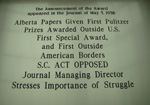Summary
The Edmonton Journal serves Canada’s fifth-largest community with a six-days-a-week (Monday-Saturday) broadsheet. Edmonton has a population of about 878,00 residents (2014 census), and it’s the capital of Alberta Province. The Journal’s paid circulation in 2014 was about 63,000, weekdays, and 69,000, Saturdays (newspaperscanada.com).
Three local Edmonton businessmen founded the Journal in 1903 as a rival toAlberta's first newspaper, the 23-year-old Edmonton Bulletin. In 1912, the Journal was sold to the Southam family, and The Journal remained under Southam ownership until 1996.
Canada’s First Pulitzer
In 1937, The Journal came into conflict with Alberta Premier William Aberhart’s attempt to pass a so-called Accurate News and Information Act that required newspapers to print government rebuttals to stories the provincial cabinet deemed "inaccurate."
After successfully fighting the law, The Journal became the first non-American newspaper to be honored by The Pulitzer Prize committee at Columbia University. In 1938, The Journal received a special bronze plaque for defending the freedom of the press, which it still proudly displays.
After two subsequent owners, the Postmedia group purchased The Journal in 2010. The Journal is one of the largest circulation dailies in what then was Postmedia’s ten major-newspapers chain.
In April 2015, the Postmedia empire expanded with the purchase Sun Media Limited’s English-language community and trade publications from Quebecor Inc., which included the Edmonton Sun, an Edmonton tabloid. (In September 2015, The Edmonton Sun was still compiled and edited independently.)
Consolidation
After the 2010 purchase, Postmedia reduced staff and consolidated functions among the newspapers in its chain. At the same time, it established a national production center – copyediting and layout – in Hamilton, Ontario. However, The Journal’s editor, Margo Goodhand, says in Edmonton Postmedia has been intent upon “salvaging, saving and preserving a news operation that works.”
Postmedia created a de facto “corporate newsroom across the country,” drawing on reporting from all its properties. Postmedia newspaper editors “communicate daily” to share features and other news. In addition, Postmedia eliminated the publisher position at The Journal, so, in addition to managing Journal newsroom, Editor Goodhand also fulfills key community relation chores traditionally handled by a publisher.
All this consolidation mirrors the effects caused by shrinking North American print advertising revenues, which has accompanied the rising interest in digital news media and the concomitant shifts in readership the digital options have created.
From her perspective, Margo Goodhand sees The Journal’s competition mainly as a contest for readership waged by The Journal, in print and online, against the CBC’s digital news site, local TV news websites, and other digital news outlets, rather than other newsprint products.
Watchdog reporting
Amid the reimaging of her newspaper, Editor Goodhand is confident the Journal can maintain its “watchdog reporting” role.
She points with pride to The Journal’s award-winning “Fatal Care” series, published in November 2013. The multi-part investigative report, written in cooperation with The Calgary Herald, documented the unreported deaths of 145 foster care children in Alberta over the period 1999-2013.
We “continually question and continually push” for information from the provincial government, says Goodhand. So, she says, their “reimagined newspaper” still is practicing solid local reporting at its core.
Please follow us and comment on Facebook.
-- Sara Brown and Paul Steinle














